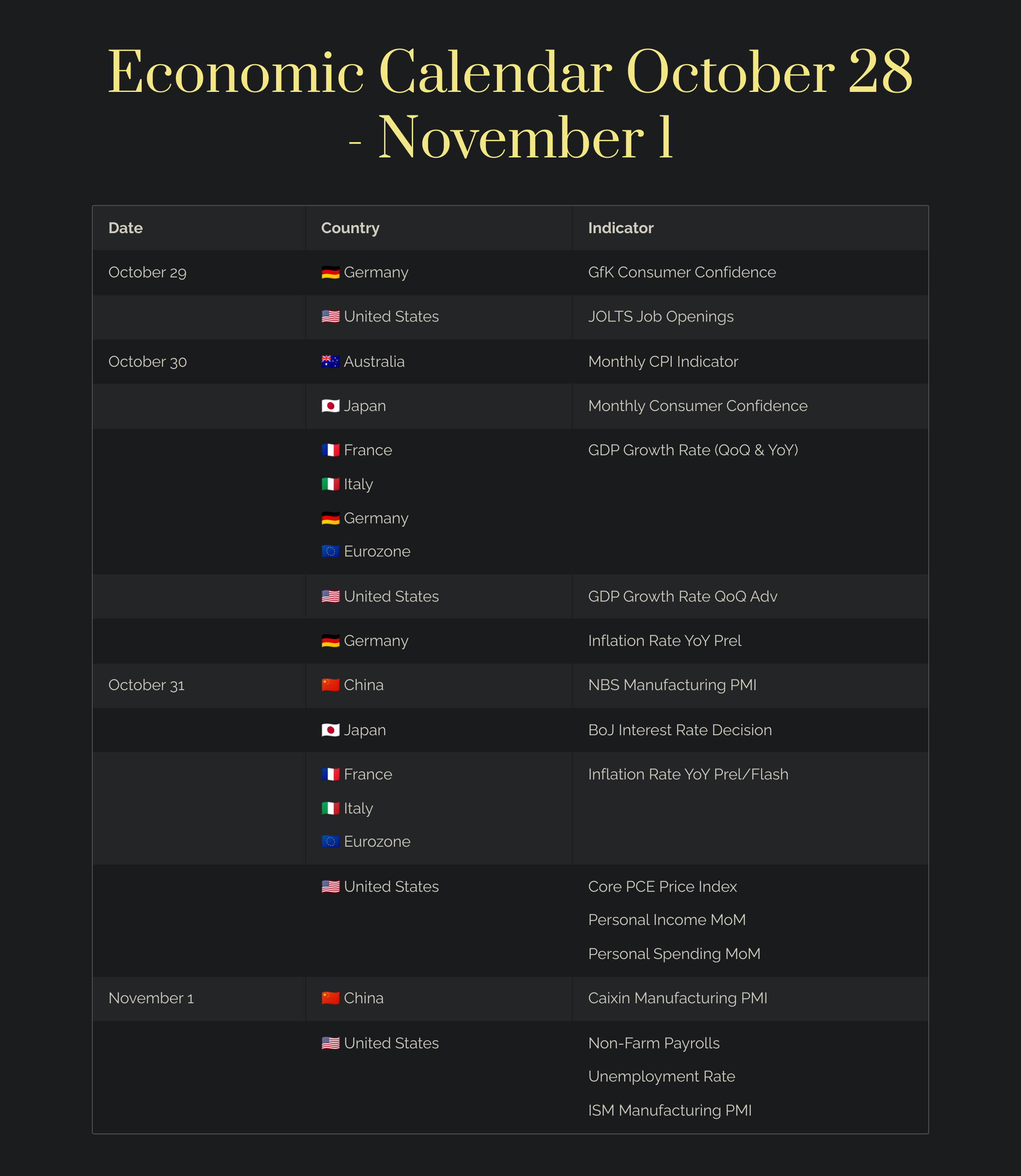Hello, fellow traders!
This week’s economic calendar includes crucial events that will give us insights into consumer confidence, economic growth, inflation, and employment. On Tuesday, traders are anticipating the U.S. JOLTS Job Openings data, followed by European and Eurozone GDP growth figures on Wednesday. The Bank of Japan’s interest rate decision on Thursday will be a key focus, and Friday brings China’s Manufacturing PMI and U.S. employment numbers.
Here’s a snapshot of all the high-priority economic events for Oct 28 - Nov 01.
Let's dive into the specifics:
Tuesday, October 29
🇩🇪 Germany’s GfK Consumer Confidence: a monthly survey that measures how optimistic or pessimistic German consumers feel about their economy and gives an overview of German households' spending attitudes and financial expectations.
🚨 Why it matters for Gold: Germany has the largest economy in the European Union, so if German consumers are feeling upbeat and spending more, it often reflects positively on the entire EU economy. Conversely, if they’re holding back on spending, it can indicate economic slowdown, which has implications beyond Germany itself.
📈 Higher-than-expected GfK confidence:
→ suggests economic strength, which generally supports the euro. A stronger euro often leads to a weaker dollar, given that they’re inversely correlated. This might boost Gold demand and push up Gold prices.
→ often correlates with increased spending, which can drive inflation higher in Germany and the wider EU.
→ might lead to hiking interest rates to keep inflation under control, which is generally negative for Gold.
📉 Lower-than-expected GfK confidence:
→ can signal potential issues for the EU economy. This could lead investors to seek “safe-haven” assets like Gold.
→ often weakens the euro, which could boost the dollar and put downward pressure on XAU/USD.
→ though if market fears of EU economic instability rise, Gold might see some safe-haven inflows, limiting the downside or even pushing prices up.
🇺🇸 The U.S. JOLTS (Job Openings and Labor Turnover Survey) Job Openings: shows the number of open jobs in the U.S. at the end of each month, along with details about hires, layoffs, and voluntary separations (quits). Essentially, it reflects how many jobs employers are actively trying to fill, providing insights into labor market strength and worker confidence.
🚨 Why it matters for Gold: one of the indicators the Federal Reserve considers when setting interest rates.
📈 Higher-than-expected JOLTS:
→ usually indicate a strong labor market, which can signal economic growth.
→ if job openings are persistently high, it suggests companies are eager to hire, which can contribute to wage increases and, potentially, inflation.
→ the Fed may respond to this with rate hikes, which often strengthen the dollar, making Gold more expensive for foreign buyers, which can push down XAU/USD prices.
→ while rate hikes often suppress Gold prices, high inflation itself can also drive investors toward Gold as a hedge.
→ can encourage investors to favor stocks over safe-haven assets like Gold, reducing Gold demand and potentially weighing down its price.
📉 Lower-than-expected JOLTS:
→ can signal a slowing economy and potential recession risks, which could make Gold more attractive as a safe-haven asset.
→ wage pressures may ease, potentially reducing inflation concerns and easing the Fed’s rate hike plans.
→ could weaken the dollar and boost XAU/USD.
Wednesday, October 30
🇦🇺 Australia’s Monthly CPI (Consumer Price Index) Indicator: provides a more frequent view of consumer price changes compared to the quarterly CPI, which used to be the only official inflation measure in Australia. It helps policymakers, businesses, and investors get a quicker read on
Keep reading with a 7-day free trial
Subscribe to The Gold Trader to keep reading this post and get 7 days of free access to the full post archives.





